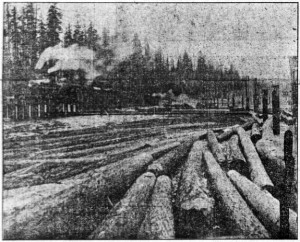Overview
One of the major industries in Oregon is lumber. Oregon is one of the greenest states in the United States. Its history reflects a time when there was an excess of trees; as settlers realized the usefulness of lumber, over-cutting and negative lumber practices diminished the amount of trees in Oregon. This article provides an interesting account of the famous Douglas fir tree before Oregon transformed into a lumber-producing state. This lesson provides students with a direct connection to the state as well as its history. Additionally, students are exposed to figurative language. This lesson can be used within a poetry unit or a social studies unit, as it provides students with primary, relevant documents from Oregon’s history.
Oregon Common Core State Standards
Language Arts Standards:
- ELA.L.4.5 Demonstrate understanding of figurative language, word relationships, and nuances in word meanings.
- ELA.L.4.5a Explain the meaning of simple similes and metaphors (e.g., as pretty as a picture) in context.
- ELS.W.4.3 Write narratives to develop real or imagined experiences or events using effective technique, descriptive details, and clear event sequences.
- ELA.W.4.4 Produce clear and coherent writing in which the development and organization are appropriate to task, purpose, and audience.
- ELA.W.4.5 With guidance and support from peers and adults, develop and strengthen writing as needed by planning, revising, and editing.
- ELA.W.4.10 Write routinely over extended time frames (time for research, reflection, and revision) and shorter time frames (a single sitting or a day or two) for a range of discipline-specific tasks, purposes, and audiences.
Materials
- Historic Oregon Newspapers website
- Copies of the article “From Forest to Mill”
- Highlighters
- Figurative language activity sheet
- Figurative language graphic organizer
- Lined paper
- Poster paper
- Markers
Key Vocabulary
- Metaphor
- Simile
- Figurative language
- Descriptive word
- Felling
- Personification
Add any additional vocabulary terms from the article that may seem difficult to understand or are interesting.
Lesson
- Introduction: Using figurative language to not only engage audience, but also keep this level of engagement.
- Some discussion questions to consider:
- What kinds of books do you enjoy reading?
- Why do you think you enjoy reading those books?
- What does the author do to make it so interesting?
- Which books do you not enjoy reading?
- Why do you think you don’t enjoy reading those kinds of books?
- Introduce figurative language: A writing style that uses a variety of descriptive words and tools, such as similes, metaphors, and personification, to depict a vivid image in the audience’s mind. In this form of writing, objects are given human qualities, an object is described in exaggeration, or events are described with action words of natural sounds.
- Use this discussion time to remind students about prior lessons on writing styles.
- Remind students that this kind of writing usually occurs in literature and fiction.
- Create an anchor chart that students may refer to throughout the unit.
- Read aloud: Read the article to the class as a whole group.
- The semantics during this time period are different from what students usually read, thus repeated readings of the article is necessary. Giving students this pre-exposure will benefit their future comprehension during the activity.
- Activity: The objective of this lesson is for students to read the article and find examples of figurative language usage. Model the activity before having students work with partners or in groups.
- Optional: Provide students with a graphic organizer to write down the examples they find. One is provided in PDF Download.
- Reread article: Reread the article with the whole class, stopping at various examples of figurative language. At this time, use highlighting as a tool to assist student comprehension. Students may highlight the specific type of figurative language used and label it so that they could refer to it later.
- Some examples of places to stop are: the type of adjectives used, personification “laugh at Echo, sleeping in her hidden caves,” etc.
- Once several examples have been found, have students work with partners or in groups to analyze the article.
- Debrief: Gather students to discuss their findings.
- Some debrief questions to consider:
- What are some examples of figurative language that you have found?
- Do you think this made the article interesting?
- If we read the article without this example, would it still be interesting?
- Would you change it to something else?
- Did you like this article?
- Why did you like or dislike this article?
- Some discussion questions to consider:
Extension Activity Ideas
Activities can be modified several different ways, depending on the grade level and focus of study. Listed are activity ideas that can be adapted and extended to and for any grade level.
- Write a Narrative: Students should write about the same topic as the article (Douglas fir trees) or a topic that is Oregon-related. They should be given a graphic organizer to help create their pieces; one is provided below. This narrative can be in the form of an article, poem, essay, etc. Give students the option to write using whatever medium they prefer. Once the narratives are written, have students perform their pieces for the whole class.
- Photograph Analysis: Print out larger copies of photographs that are presented in the article. Using these copies, discuss aspects of the photographs that could be different or similar with the type of photography that is done presently.
- Some discussion questions to consider:
- What does this photograph tell me?
- Why did the photographer take this picture?
- Do you think this photograph is fiction or nonfiction? How do you know, and why?
- Is it a fair and accurate portrait of the past?
- Some discussion questions to consider:
- Discussion questions, and lesson ideas adapted from “Picture This: Using Photographs to Study the Past” from Education Station.


Leave a Reply